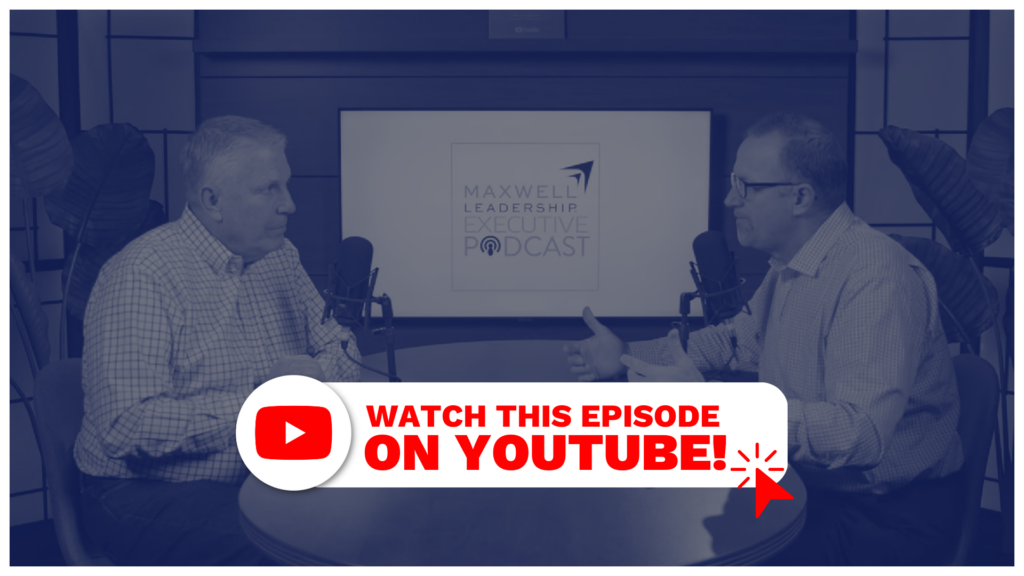Executive Podcast #275: Leading Through Change (Part 2)

In part 2, we explore leading through change with practical advice and insights. Discover the five key questions people have about their leader during change, and why walking the talk matters. Learn the contagious impact of belief and commitment on the team. The episode emphasizes trust-building through genuine connections and clear communication. It’s a short, impactful guide to effective change leadership.
References:
Become a Maxwell Leadership Certified Team Member!
Register for Day to Grow on March 9th, 2024!
Download our Learning Guide for this podcast!
Perry Holley:
Welcome to the Maxwell Leadership executive podcast, where our goal is to help you increase your reputation as a leader, increase your ability to influence others, and increase your ability to fully engage your team to deliver remarkable results. Hi, I’m Perry Holley, a Maxwell leadership facilitator and coach.
Chris Goede:
And I’m Chris Goede, executive vice president with Maxwell Leadership. Welcome and thank you for joining. Hey, before we get started, if you’re interested in the five levels of leadership or the 360 degree leader, which is a content piece that you’re working on right now and continuing to improve that, but we’ve been delivering it to clients for years and just been doing a lot of that recently with the people that are like, man, I need to become better at leading across to my peers or to my leader or down or whatever it might be. Go to maxwellleadership.com/podcast there. If you’ll click on this podcast, there’s a form there at the bottom. You fill that out, let us know, and we’ll get back in touch with you to tell you what that looks like. Well, today’s topic is leading through change part two. So if you missed last episode, I want to encourage you to go back, listen to that one as well as we really talk about leading through change.
Chris Goede:
And we gave some very practical ways that that happens. Perry just recently had finalized a course that we’ve rolled out now as part of our training in order for people to become more effective change leaders. And so today we’re going to dive in, we’re going to talk a little bit further about leading change and give you some more content to take with you.
Perry Holley:
Yeah. So last week we talked about becoming a change agent. Are you okay with status quo, or do you see the need for improvements, for growth, for opportunity to do new things to support clients or to improve your effectiveness? Today I thought we’d talk about kind of tiling at five questions everyone’s asking about you when it comes to leading change. I’ve got this lesson I really enjoyed learning about was a commander Flyer for the Blue Angels. He captained the Blue Angels special flight operations team. His name is George Dom. George got a couple of TED talks and some things were really great, but he was talking about an importance of trust. It got my attention when he says, so you’re in an f 18 going 500 miles an hour, 3ft wingtip to wingtip from you.
Perry Holley:
And so you absolutely, without a doubt trust your leader. You got all eyes on that lead plane, 100% trust or you die. And I thought, okay, you got my attention now I’ll listen to that. But I related this to, and he talked about it as well, leading. When things are changing, things are moving fast and changing. Do you trust the team? Do you trust the leader? And I thought, let me just bring a few of these and get your thoughts on it. And he talks around around five c’s. But I put the question in there as well.
Perry Holley:
So the first one, the c is character, but the question is, do you walk your talk? And you and I have talked about it, people are watching you all the time, and your actions say a lot more than your words. But what does that have to do when you’re leading change and the trust is in question, are you walking your talk?
Chris Goede:
Yeah, I think your team will obviously see if you believe in change. We’ve talked about this as well, but they want to see you changing. Just like leadership is contagious, I think change successfully making changes is contagious, actually unsuccessful change. Yeah, that’s right. It’s contagious both ways. Right. Just like leadership is. And so if you want to talk about change, it’s important to you make sure that your team, or those that you have influence with see change in you.
Chris Goede:
And, oh, by the way, as you are developing and learning and changing, which that happens when we go through a process like that. Share what you’re learning from the change. Share what the outcomes were from the change. How did what we change here in the organization end up showing up on the bottom line or end up showing, whatever it might be, increased client engagement, whatever it might be, show it. And talk about the impact that the change has had, that you as a leader and the team actually fleshed out.
Perry Holley:
If you’re leading a change effort and people don’t see you playing by those rules, your talk is not matching your walk. Number two, talking about second c was commitment. And he talks about, will you be with us when the going gets tough? And if you’ve ever been in a change effort, especially a significant change effort, the going always gets tough. And people start to question and people start to wonder, why are we doing that? And so they’re looking up and saying, where are you and are you there? People looking around to see, are you involved? Are you present? Are you leading? And so are you committed to us when things get going tough?
John Maxwell:
Hey, John Maxwell here. I’m in the studio. We’ve been recording all day and I was thinking about really one of my very favorite experiences that we have, and that is called day to grow. If you want to grow, you want to grow in every area of your life. I tell people all the time, you don’t want to go to something, you want to grow to something. But if you’re passionate about personal growth, development, your team and growing them, you do not want to miss day to grow. I’m going to have some real players with me. Dion Sanders, Jamie Kern, Lima, myself. Oh my gosh.
John Maxwell:
You don’t want to miss it. So market, come and see us on day to grow. I will promise you this. You come and bring your team. At the end of the day, you’ll come up and shake my hand and say, one of the best days I’ve ever invested in for myself and for my team. I’ll see you there.
Chris Goede:
Mark Cole, our CEO, has this statement that says, hey, this is the best you’re going to feel about this change for a while. Meaning when you make the decision to make that change, that’s the best. Yeah, we’re going to do that. That’s a great idea. And then you walk out and you go, oh, my goodness. But leaders, that’s when leadership is made. Leadership is made in the hard, and it’s not going to be easy. And they need to hear your voice and they need to see you being involved in it.
Chris Goede:
And so, man, when things get tough and the change that you guys are driving is the reason for it’s getting tough. And even if it’s not, you need to be rolling up your sleeves and getting involved, because that’s how your team will begin to trust you. Even if the change doesn’t work, that’s okay, right? If it doesn’t work. But, man, when the going gets tough, if they see your commitment to them and the change, even if it doesn’t work, you’re going to have their buy in for future it.
Perry Holley:
Love it. The third c that George Dom talked about that the Blue Angels used was competence. That are you good enough to lead us? And my thought here went to the old argument about is leadership, EQ, your emotional intelligence, your people skills, or IQ, your literal intelligence, your competence in the role. And while EQ by far is the most important component, most studies say it’s 85% EQ people skills, over 15% IQ. However, IQ is the ticket to admission that no matter how great a people person you are, you could be the greatest people person on the planet. But if you’re incompetent in your work, I’m not going to trust you, I’m not going to follow you, I’m not going to buy into that. So your iq is a ticket to admission. You have to be competent in what you do.
Perry Holley:
And I wondered how that shows up to you. Do you think when you’re leading a change effort, where does competence, I mean, you can be making people feel good, doing all the people skills, but if you’re not competent, how does that show up?
Chris Goede:
Yeah, I think, first of all, competence in the change area doesn’t mean that you’ve actually gone through that change before. Competence may be that you understand the issue, you understand what you’re trying to expand or to change and why you’re doing it. And so one of the things that we talk about in the sales world is stories and stats sell. So as you think about this change, you go, well, man, I’ve never let a change movement like this before. I’m not competent in this area. No, what we’re saying here is be competent in the reason why you’re helping drive the change. Right. And so when it comes to that, what I want to encourage you to do is, man, do some research, figure out some stories of people that maybe have done this before, your team or differently than your team or a different industry.
Chris Goede:
What are some of the statistics of the change happening? What could potentially the statistics be and what we’re shooting for? And when you begin to talk about stories and stats in the change, again, you’ll come across as competence on why we’re doing it, what we’re looking for, and how we’re going to measure it and hold people accountable to that. But it doesn’t necessarily mean you’ve led a particular change movement like that.
Perry Holley:
Yeah. As you’re talking, I’m thinking last week, one of the components of a change agent, a skill you need, is what you’re asking the team to do. Does it connect to your strategy, to your organizational vision? And I’m thinking your incompetence can show if you say, hey, let’s change that. Hey, let’s change this. Hey, let’s change this and that. And it doesn’t connect. Why are we doing that? And if they say, you’re just trying to mix things up, you don’t really have a strategic organizational purpose for why we’re trying to change something, people are not going to buy into that. They’re going to back off.
Perry Holley:
And so I need to, as a leader, be competent and thoughtfully business oriented about why we’re doing what we’re doing, or we’re going to have a struggle with that.
Chris Goede:
Or I think I heard you even say recently, oh, is this the flavor of the new year? We’re going to change that again, right?
Perry Holley:
I told you not to invite me to those team meetings. I just always say something to get me. All right. Number four of these ideas around building trust that drives change was, do you understand us, that the team, the fourth c would be connection? And so captain Dom talks about that trust is easier to build when you know and understand those on your team. When you built the relationships you’re having, the connection we did several weeks ago, did a talk around, talking about connection, how important that was, that people, when you understand their strengths and weaknesses, when you know what they’re going through, when you understand how this is affecting them, you actually think about it for them. You’re for them in that you understand me. I’m much more likely to play along with the change and not be a resister, as you talked about, but more of a committed change person in that.
Chris Goede:
For you, one of the greatest ways to do this is before you roll out the change is to go seek the perspective of those that the change is going to affect more than anybody else, get them that are knowledgeable in that area and have expertise boots on the ground of who are going to be impacted the most by that change, and go get their understanding before you roll it out. And I think when you do that, people just want a voice, right? They just want to be heard. They want to know that their opinion and expertise matters. And so if you’ll do that by asking those questions and you’ll seek their input as you roll that out, you’ll connect with them. They’ll give you that benefit of the doubt that you do understand where they’re at versus just coming in saying, here’s the change, and then we’re going to all figure this out together. Right? It’s completely different.
Perry Holley:
The fifth c to wrap it up is communication. I guarantee you we will do more on this topic in the coming weeks around how do effective change leaders communicate? But George Dom really hit on this one that you’ve got to be clear, concise, direct, great change leaders are very clear about. They’re very coherent about where we’re going, what we’re trying to affect. It’s essential for building and maintaining trust that you’re clear about what’s expected and where we’re going with this. So I think we’ll talk a lot more. But your thoughts on communication and change?
Chris Goede:
Man, communication is going to show up in every team, every organization for years to come. I think that this is absolutely the foundation to any change movement. You have to communicate often you have to communicate sometimes when you don’t really even know what the answers are comes back to a friend of ours, a friend of John’s that talks about, man, sometimes they just want to hear your voice more importantly than what it is that you’re talking about. We often talk, too, about discretionary effort. When you’re asking people for change, it comes out of their normal day to day job or their day job. And now it’s going to be something a little bit more, maybe it’s going to be something a little bit different. It’s going to put a little bit of a wrinkle in the system. Well, you’re going to need a little bit more discretionary effort from your team.
Chris Goede:
And the way to do that is to make sure that you’re communicating to them clearly and directly and often. And by doing that, you’re going to connect with them, which, by the way, ties back to level two and the five levels of leadership to where they’ll give you some discretionary effort through the process.
Perry Holley:
I think the worst thing you can do as a change leader is leave people in the dark wondering what’s going on, wondering why we’re doing this. They start to question the why themselves. They might start to question you. They might even question your motive, what’s behind this. Then they start to question your competence. It goes back to some of the other of these five C’s we talked about. That communication probably should make that number one. If you’re not communicating clearly, it’s going to open up a lot of these other c’s that are going to be a problem in the change effort.
Chris Goede:
Yeah. Well, as we wrap up, man, again, I just want to encourage you, if this lesson or the lesson that we did before, part one on change, if it resonated with you, I want to encourage you to head to the website, fill out the form. I know Perry personally would love to coach or even facilitate a leadership team or a team through some change, but we also have an incredible bench of men and women of coaches that do this for us that are in the field every day. My last thought for you is this. Sustainability in your organization and in your leadership is all about change. But I want to encourage you that you have to change at the speed and the pace of which the capacity of those around you have for change. And if they have the capacity for that change and you begin to follow some of our tips and techniques from last week, some of the questions and things we’re going to challenge you with on this lesson, then I think you’re in good shape. It’s not easy no, it’s not easy, but it’s something that has to happen in order for us to have sustainable success.
Perry Holley:
Fantastic. Well, as Chris said, if you want to learn more about our offerings, if you’d like to learn about our other in our podcast family, we’ve got other podcasts you can find there. If you’d like to leave us a question about any of this or a comment, you can do all that at MaxwellLeadership.com/Podcast. We always love hearing from you, and we’re very grateful you’d spend this time with us today. That’s all today from the Maxwell Leadership executive podcast.
To be a Successful Leader, You Need Feedback on Your Leadership.
We’re excited to announce our new and improved Organizational Effectiveness Survey (OES). The OES gathers feedback from employees to give leaders and management the knowledge and action plans needed to develop a more effective and productive work environment. Our new version measures 4 areas of your business: Leadership, People, Strategy, and Performance.













Be the first to comment on "Executive Podcast #275: Leading Through Change (Part 2)"